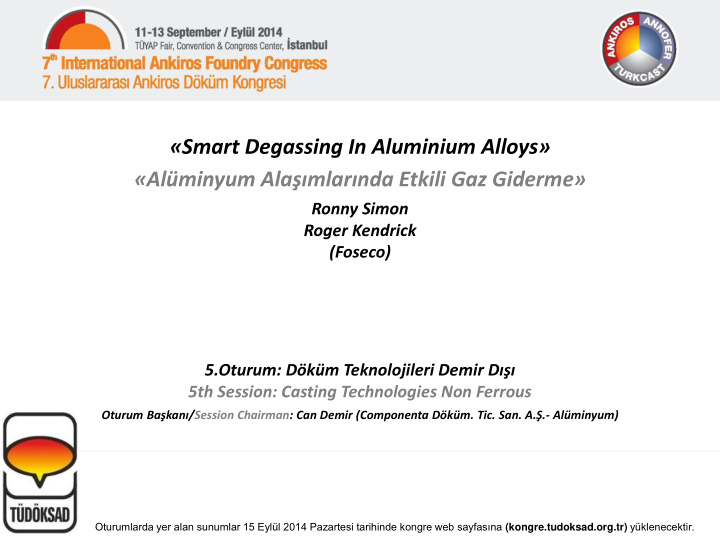



« Smart Degassing In Aluminium Alloys » «Alüminyum Alaşımlarında Etkili Gaz Giderme » Ronny Simon Roger Kendrick (Foseco) 5.Oturum: Döküm Teknolojileri Demir Dışı 5th Session: Casting Technologies Non Ferrous Oturum Başkanı/ Session Chairman: Can Demir (Componenta Döküm . Tic. San. A.Ş. - Al üminyum ) Oturumlarda yer alan sunumlar 15 Eylül 2014 Pazartesi tarihinde kongre web sayfasına (kongre.tudoksad.org.tr) yüklenecektir.
Intelligent Degassing – Studies on Controlling the Hydrogen Removal from Aluminium Ronny Simon Roger Kendrick Foseco Foundry Division Europe
Agenda Hydrogen solubility and removal Mixing purpose and rotor functions in aluminium degassing Pumping vs. Non-pumping designs Homogenising Capability of Rotors in Water Degassing Efficiency over Rotor Service Life Intelligent Degassing - SMARTT Summary and Conclusions 2
Hydrogen Solubility Gas porosity in aluminium is a well known phenomena for many years Unacceptable surface quality Surface blistering after heat treatment Leakage problems Reduced mechanical properties 3
Factors Influencing Hydrogen Solubility Temperature (liquid – solid) Hydrogen Solubility 10 1 Hydrogen Content in ml/100 g Al 0,1 0,01 0,001 0,0001 200 300 400 500 600 700 800 900 Temperature in ° C 4
Factors Influencing Hydrogen Solubility Temperature (liquid – solid) Alloy composition Magnesium increases solubility Copper, silicon and zinc degrease solubility 5
Factors Influencing Hydrogen Solubility Temperature (liquid – solid) Alloy composition Ambient conditions 6
Principle of Hydrogen Removal Start with a dry inert gas bubble Establishing a local equilibrium between: - Hydrogen concentration in diffusion layer - Partial pressure of hydrogen in the inert gas bubble Hydrogen concentration in inert gas bubble increases H Atom, solved in melt H 2 Molecule within inert gas bubble Inert gas Boundary layer of diffusion 8
Mixing purpose and rotor functions Small inert gas bubbles for bigger surface Slow vertical bubble movement Homogeneous bubble distribution Homogeneous temperature and alloying element distribution Lance Porous block Rotary degassing 9
Mixing purpose and rotor functions Rotor characterisation Homogenising Gas dispersion Suspension of solids Liquid-liquid-blending Heat transfer Reactions 7
Pumping vs. Non-pumping designs Pumping rotor Non-pumping rotor 10
Homogenising Capability in Water Pumping rotors Non-pumping rotor Type XSR Type FDR Trial procedure: 350 rpm rotor speed Pictures taken 4 seconds after ink addition 11
12
Homogenising Capability in Water Water filled Perspex tank (60 cm diameter, 90 cm depth) 250 – 260 kg of water 8 type T thermocouples Addition of 7000 ml of hot water @80 ° C Rotors run at 400 rpm 13
Homogenising Capability in Water Pumping rotors Non-pumping rotors 14
Efficiency over Rotor Service Life Design, shape and size significantly impact the ability to degas aluminium melts. Does each particular rotor perform well throughout the entire service life? What is the true valuable life of a rotor and therefore when should a rotor be changed? 15
Efficiency over Rotor Service Life Trial procedure: 200 kg crucible furnace with AlSi10Mg at 750 ° C 175 mm diameter rotor at 320 rpm and 15 l/min nitrogen 52 – 54 % rH and 25 ° C Hydrogen curves were recorded by the ALSPEK H hydrogen analyser. 16
Efficiency over Rotor Service Life Comparison between new rotors 0,45 0,40 Hydrogen in ml/100g Al 0,35 0,30 0,25 Pumping Non-pumping 0,20 0,08 ml/100g Limit 0,15 0,10 0,05 0 50 100 150 200 250 300 Treatment time in seconds Target limits: Pumping rotor: 0,08 ml H 2 / 100 g Al Non-pumping rotor: 0,10 ml H 2 / 100 g Al 17
Efficiency over Rotor Service Life Pumping rotor New After 25 % After 50 % After 75 % Overdue of total service life 18
Efficiency over Rotor Service Life Pumping rotor New After 25 % After 50 % After 75 % Overdue of total service life 19
Efficiency over Rotor Service Life Non-pumping rotor New After 10 % After 75 % After 95 % of total service life 20
Efficiency over Rotor Service Life Non-pumping rotor New After 25 % After 50 % After 95 % of total service life 21
Efficiency over Rotor Service Life Comparison of Results Limit [ml H 2 /100 g Al] 0,08 0,10 Time to limit new rotor [s] 230 220 Time to limit used rotor [s] 250 260 Fading over service life [%] < 10 > 20 Pumping rotors provide consistent degassing efficiency because they compensate a loss in outer diameter and rounded edges by oxidation of the graphite actually increasing the pumping chamber size. Foundries must define a maximum number of cycles or limit samples. 22
Intelligent Degassing - SMARTT Extensive laboratory work has enabled Foseco and tsc to develop a mathematical model which can be the basis of an intelligent system 23
Intelligent Degassing - SMARTT This model recognises changes in external conditions such as ambient temperature, atmospheric humidity and rotor wear, and can then catered for them during the subsequent metal treatment cycle. 23
Intelligent Degassing - SMARTT 23
Summary and conclusions Pumping Rotors are far more efficient than non-pumping rotors in terms of mixing, improving metal quality, offering melt quality consistency and reducing the cost per treatment. Currently the efficiency loss experienced must be added to the treatment time for new rotors to reach the limit throughout their life. Degassing with a Foundry Degassing Unit using the mathematical model offers a further step forward in Process Control. SMARTT enables foundries to run the degassing process independent from operator involvement and getting reliable and constant results. 24
Additional information Ronny Simon Roger Kendrick Vesuvius GmbH Foseco UK Ltd. Foseco Foundry Division Drayton Manor Business Park Gelsenkirchener Strasse 10 Tamworth, Staffordshire D-46325 Borken B78 3TL Germany United Kingdom Ronny.Simon@foseco.com Roger.Kendrick@foseco.com www.foseco.com www.foseco.com 25
Recommend
More recommend